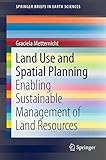Land Use and Spatial Planning : Enabling Sustainable Management of Land Resources / by Graciela Metternicht.
Material type: TextSeries: SpringerBriefs in Earth SciencesPublication details: Australia : Springer Publishing Company, Inc., 2018Edition: 1st ed. 2018Description: 1 online resource (XVII, 116 pages 16 illustrations)ISBN:
TextSeries: SpringerBriefs in Earth SciencesPublication details: Australia : Springer Publishing Company, Inc., 2018Edition: 1st ed. 2018Description: 1 online resource (XVII, 116 pages 16 illustrations)ISBN: - 9783319718613
- Environmental geography
- Environmental law
- Environmental management
- Environmental policy
- Regional economics
- Regional planning
- Spatial economics
- Sustainable development
- Urban planning
- Landscape/Regional and Urban Planning
- Environmental Geography
- Environmental Law/Policy/Ecojustice
- Environmental Management
- Regional/Spatial Science
- Sustainable Development
- 710 23 M595l
| Item type | Current library | Call number | Copy number | Status | Date due | Barcode | Item holds | |
|---|---|---|---|---|---|---|---|---|
 Books
Books
|
Library, Independent University, Bangladesh (IUB) Reference Stacks | 710 M595l 2018 (Browse shelf(Opens below)) | 01 | Not For Loan | 027047 |
1. Introduction.- 2. Planning: definitions and evolution in the context of SLM -- 3. Principles of best practice in land use planning for SLM -- 4. Contributions of land use planning to sustainable land use and management -- 5. Concluding remarks -- 6. References.
This book reconciles competing and sometimes contradictory forms of land use, while also promoting sustainable land use options. It highlights land use planning, spatial planning, territorial (or regional) planning, and ecosystem-based or environmental land use planning as tools that strengthen land governance. Further, it demonstrates how to use these types of land-use planning to improve economic opportunities based on sustainable management of land resources, and to develop land use options that strike a balance between conservation and development objectives. Competition for land is increasing as demand for multiple land uses and ecosystem services rises. Food security issues, renewable energy and emerging carbon markets are creating pressures for the conversion of agricultural land to other uses such as reforestation and biofuels. At the same time, there is a growing demand for land in connection with urbanization and recreation, mining, food production, and biodiversity conservation. Managing the increasing competition between these services, and balancing different stakeholders' interests, requires efficient allocation of land resources.
Computer Science and Engineering Reference Stacks
